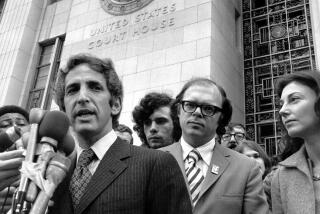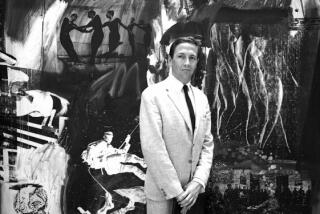ART REVIEW : ‘Secrets’ Looks at Freedom Through the Rosenberg Case
- Share via
The 1953 executions of Julius and Ethel Rosenberg aren’t In “Unknown Secrets: Art and the Rosenberg Era,” on view at Otis/Parsons Art Gallery through Jan. 6, 49 artists commemorate Julius and Ethel Rosenberg, who were executed as spies in 1953. The exhibition reminds us of how terribly fragile freedom is.
Curated by Nina Felshin, “Unknown Secrets” will travel to eight U.S. cities over a period of 2 1/2 years; it’s heartening to know that this comprehensive and important exhibition will be seen by so many.
Married and the parents of two young children, the Rosenbergs were a middle-class couple from New York’s Lower East Side who were arrested in 1951 and convicted of leaking secrets pertaining to atomic weapons to the Soviets. Ethel’s younger brother, David Greenglass, who was also under suspicion, turned the couple in to save his own neck and was instrumental in sending them to the electric chair.
The case inspired countless investigations, poems, plays, films, novels, stories and songs, and “Unknown Secrets,” accompanied by an in-depth catalogue, attempts to acknowledge all of it. In addition to the Rosenbergs, this ambitious show explores several related themes, including authority, history, memory, censorship, the arms race, the right to dissent, capital punishment, anti-Semitism, espionage and anti-communism. Of 60 works in the show, 60% are contemporary works made at the invitation of the show’s curator, while the rest are historical works created as a form of protest at the time of the incident.
Vintage works include pieces by Fernand Leger, Alice Neel, Arnold Mesches and Mort Dimondstein, a lithograph by Picasso made to help raise funds for the Rosenberg defense, and woodcuts--one of which depicts Ethel burning at the stake--by Rockwell Kent. Made during the height of the Abstract Expressionist movement, political art of this sort was considered a secondary form at the time. Catalogue essayist Paul Von Blum offers an explanation for that with the suggestion that Abstract Expressionism came into vogue and outdistanced topical art during this paranoid period partly because there was nothing overtly political about it.
Of the recent work, Sue Coe’s “Needs of the State” stands out as a high point of the show. One of the most hard-hitting political artists working today (“Porkopolis,” her new body of work indicting the meat-packing industry, drew rave reviews during a recent New York showing), Coe has a created a dark, nightmarish image that finds a man with the word truth emblazoned on his chest frying in the electric chair. A gallery of prominent figures--among them Einstein, Picasso and Lillian Hellman--await execution.
Robert Arneson shows bronze busts of the Rosenbergs with 2 fried commie jew spies tattooed on their foreheads, while Peter Saul offers a lurid portrait of Ethel in the electric chair. Dennis Adams installed blow-ups of news photos of the Rosenbergs and their tormentors (McCarthy, prosecuting attorney Roy Cohn, Eisenhower) in New York bus shelters, while Leon Marcus shows a portrait of Cohn cast as Judas.
The fact that the Rosenbergs refused to plead guilty made them political fanatics in the eyes of the press, but they maintained their innocence to the end. Supporting them at the time were most influential European thinkers, who were united in their belief that the Rosenbergs were innocent.
More to Read
The biggest entertainment stories
Get our big stories about Hollywood, film, television, music, arts, culture and more right in your inbox as soon as they publish.
You may occasionally receive promotional content from the Los Angeles Times.










